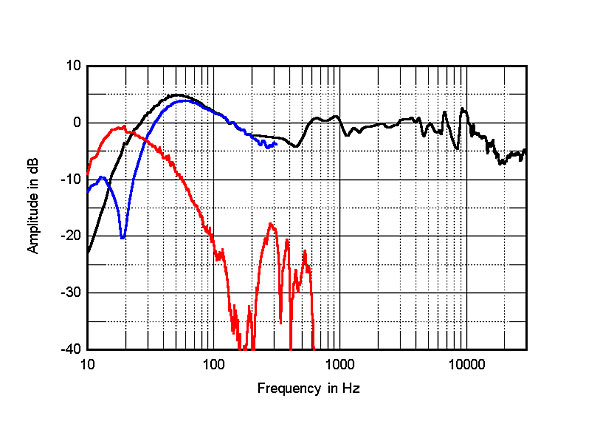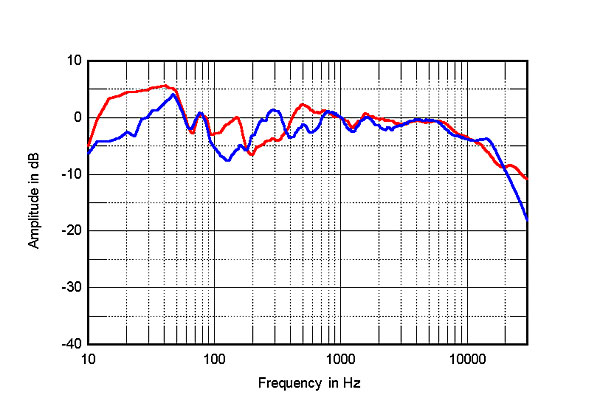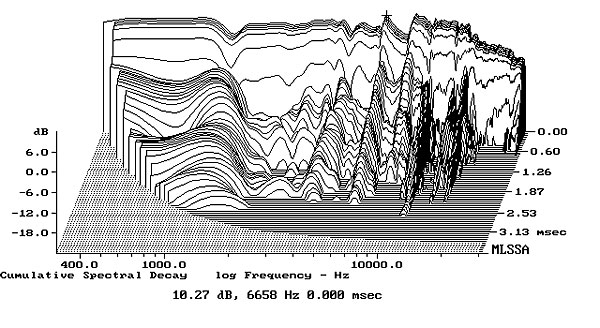| Columns Retired Columns & Blogs |
Time for some bass traps Michael, and judicious application of DSP! I have a small listening room and have enough bass to pulverize kidney stones when asked for it. :) Those in room graphs are crying for TLC.
I used DRA Labs' MLSSA system and a calibrated DPA 4006 microphone to measure the Marten Coltrane 3's frequency response in the farfield; for the in-room and nearfield frequency responses, I used an Earthworks QTC-40. Because of the Coltrane 3's size and weight, I traveled to Michael Fremer's place to measure the speaker in situ, but it was too heavy for us to lift it very high off the ground. The earlier-than-usual reflections of the drive-units' output from the ground meant that I had to aggressively window the impulse-response data, thus compromising the resolution in the midrange.
Fig.1 shows the Coltrane 3's electrical impedance and phase. The impedance remains above 6 ohms for the entire midrange and treble regions, and though the magnitude drops to a minimum value of 3.1 ohms between 72 and 93Hz, the phase angle is close to 0° in this region, ameliorating any driving difficulty for the partnering amplifier. Any amplifier specified as being able to drive 4 ohms will work well with the Coltrane 3—something not true of the original Coltrane, which we reviewed in 2005. The Coltrane 3's voltage sensitivity is specified as 88dB/2.83V/m. My estimate of the sensitivity on the tweeter axis was lower, at 84dB(B)/2.83V/m, but this was reduced by a lack of mid-treble energy on this axis.

I always begin my measurements of a speaker's behavior on the tweeter axis, as this is both easily repeatable and, very often, the intended listening axis. However, the Marten's tweeter is a high 45" from the ground, and you can see from the step response on the tweeter axis (fig.2) that while all the drive-units' outputs are in positive acoustic polarity, and even with the tilt-back of the speaker's front baffle, the tweeter's output (the sharp up/down spike) is slightly ahead of the combined output of the midrange unit and woofers (footnote 1). Moving the microphone down a few inches will push back the tweeter's output so that it coincides with the lower units' outputs, resulting in an excellent, time-coincident, right-triangle shape to the step (footnote 2), confirming Marten's claim that the Coltrane 3 is "100% time and phase coherent."

This was confirmed by comparing the farfield frequency responses on the tweeter axis and 5° below the tweeter axis, approximately level with the midrange unit and 38" from the ground (footnote 3). The tweeter-axis response has a large suckout in the crossover region, which will have affected the measured sensitivity on this axis. By contrast, the response on the lower axis (fig.3) is relatively even from the upper midrange up to the top octave, though there appears to be a slight lack of energy above 10kHz and in the lower midrange. Unfortunately, as I mentioned before, the graph's resolution in the latter region will have been affected by the windowing of the impulse response to eliminate floor reflections.

The saddle centered on 19Hz in the impedance-magnitude trace (fig.1) suggests that this is the tuning frequency of the large port. The port's response, measured in the nearfield, is shown as the red trace in fig.3. This peaks between 12 and 36Hz, and though some low-level resonances can be seen in its midrange output, their audibility will be reduced by the fact that the port fires downward from the enclosure's base. The two woofers behave identically, and their summed output is shown as the blue trace in fig.3. As expected from the impedance plot, their response has a sharply defined notch at the port-tuning frequency of 19Hz, and the use of first-order filters means that the woofers roll out slowly above 320Hz, where they're crossed over to the midrange unit. The black trace below 300Hz in fig.3 shows the complex sum of the woofer and port outputs, and though there is the expected peak in the midbass due to the nearfield measurement technique, the peak is higher than the norm. (For all measurements, the bass control was left in the setting chosen by Marten's Leif Märten Olofsson when he set up the speakers in MF's room.)
The Coltrane 3's lateral dispersion (not shown) was even across the audioband out to 15° to the speaker's sides, though the top octave began to roll off more than 30° off-axis. In the vertical plane (not shown), the crossover region filled in both above and below the tweeter axis.
With a large speaker that has first-order crossover filters, and thus significant overlap of the outputs of its drive-units, the most important measurement is probably the spatially averaged in-room response. The red trace in fig.4 is the Coltrane 3's response in MF's listening room, generated by averaging 20 1/6-octave–smoothed spectra, individually taken for the left and right speakers using SMUGSoftware's FuzzMeasure 3.0 program and a 96kHz sample rate, in a vertical rectangular grid 36" wide by 18" high and centered on the positions of MF's ears. For reference, the blue trace is the spatially averaged response of the Wilson Audio Alexandria XLFs, taken under identical conditions in MF's room.

The two speaker models behave very similarly above 700Hz, though the Martens are smoother overall than the Wilsons in the presence region. Both speakers are affected by room modes below 400Hz, though the Coltrane 3s have less energy between 200 and 400Hz than the Wilsons, and more energy between 100 and 200Hz. The Swedish speakers have a lot of energy apparent in the low bass, whereas the American speakers are better controlled, which may be due to their ability to choose between the front and rear ports. But I note that MF wrote that the Coltrane 3 "produced the deepest bass" he'd heard in his room, which correlates nicely with this measured response. The individual measurements that were averaged to produce the red trace in fig.4 confirmed that the Coltrane 3's output above 10kHz did fall off rapidly more than 30° to the speaker's sides, meaning that experimenting with toe-in can optimize the top-octave balance.
Fig.5 shows the Coltrane 3's cumulative spectral-decay plot on the optimal axis. With its time-coincident behavior, it came as no surprise that the initial decay is very clean. However, some resonant behavior can be seen in the mid- and high treble, perhaps due to breakup modes in the midrange unit that are ineffectively suppressed by the first-order crossover filter.

Finally, although the Coltrane 3's enclosure felt very inert, listening to its various surfaces with a stethoscope as I swept a sinewave tone up and down revealed a couple of low-level modes between 270 and 350Hz, and a 130Hz tone excited a slight internal buzz. None of this behavior was audible without the stethoscope.
The decision to use a first-order crossover puts a large burden on a loudspeaker designer to get everything else right. Its measured performance suggests that Leif Märten Olofsson has done so with his Coltrane 3.—John Atkinson
Footnote 2: I measure loudspeakers at a standardized distance of 50". However, as the Coltrane 3 uses first-order crossover filters, Marten's Leif Olofsson measures the speaker at 3m (10'). Our inability to raise the Coltrane 3 very far off the ground meant that this was not possible.
Footnote 3: Leif Olofsson recommends a measuring-microphone height of 38", though he says that arranging for the listener's ear height to be between 35" and 43" (0.9–1.1m) will work for listener distances of 8' to 13' (2.5–4m).

Time for some bass traps Michael, and judicious application of DSP! I have a small listening room and have enough bass to pulverize kidney stones when asked for it. :) Those in room graphs are crying for TLC.